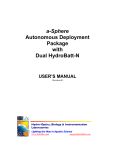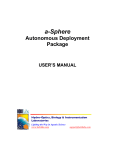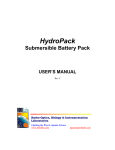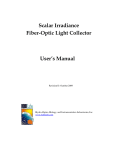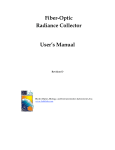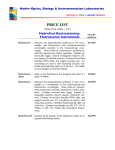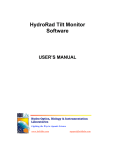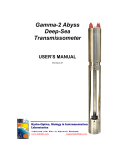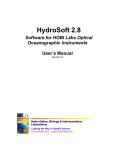Download HydroBatt User`s Manual
Transcript
HydroBatt Oceanographic Battery USER’S MANUAL Revision B Hydro-Optics, Biology & Instrumentation Laboratories Lighting the Way in Aquatic Science www.hobilabs.com [email protected] Revisions: B, September 2011: Correct cross-references A, September 2011: Initial Release 2 1 INTRODUCTION ................................................................................................................................ 5 2 PRECAUTIONS ................................................................................................................................... 6 2.1 2.2 2.3 2.4 3 USE ................................................................................................................................................. 6 CHARGING ....................................................................................................................................... 6 SHIPPING ......................................................................................................................................... 6 STORAGE ......................................................................................................................................... 6 CHARGE & DISCHARGE ................................................................................................................. 7 3.1 3.2 3.3 CHARGING PROCEDURE................................................................................................................... 7 CHARGE CHARACTERISTIC .............................................................................................................. 7 DISCHARGE CHARACTERISTIC ......................................................................................................... 8 4 SPECIFICATIONS ............................................................................................................................ 10 5 SERVICE AND SUPPORT ............................................................................................................... 11 5.1 5.2 SERVICE AND SUPPORT ................................................................................................................. 11 EQUIPMENT RETURN ..................................................................................................................... 11 3 1 INTRODUCTION The HydroBatt, shown in Figure 1, is a highcapacity rechargeable battery for powering underwater equipment. It is especially suited to powering autonomous instrumentation packages that either require high intermittent power, or long mission durations. The housing is corrosion-proof acetal plastic, conservatively designed for its 600-meter depth rating. HydroBatt contains a four-cell Lithium-Ion battery with 18 Ahr charge capacity at a nominal output voltage of 14.5 V (actual range 11.4 to 16.8 V). For even higher capacity, multiple HydroBatts can be connected together with suitable Y-cables. The standard charger charges the battery fully in a maximum of 6 hours. But the cells charge most rapidly when their charge is low, so the first 80% of a charge takes only 3 hours. Figure 1. HydroBatt 5 2 PRECAUTIONS Misusing or damaging Lithium-ion batteries can create the risk of fire or explosion. The HydroBatt includes multiple layers of protection, but it is still important to follow the following precautions carefully. 2.1 Use Avoid situations that could lead to short circuits and overload. If connecting multiple HydroBatts with Y-cables, beware the shortcircuit hazard shown in Figure 2. Do not block the pressure relief valve (see Figure 3). Figure 2. Beware of a short-circuit hazard in this situation: when one branch of the Y-cable is connected to a HydroBatt, the male pins of the other branch carry the first battery’s output voltage! 2.2 Charging Use only the charger supplied with the HydroBatt. Charge only in the 0 to 40 C temperature range. The charger is not waterproof; protect it from water and weather. 2.3 Shipping Ship securely in the original container, with original warning notices on the container. Install a dummy plug in the connector. Do not ship by air if damaged or malfunctioning. Figure 3. The black circle on the left of the end cap is the top of the pressure relief valve. Never block the valve. If it pops up, that indicates a possible hazard and you should discontinue use. 2.4 Storage If storing the battery for long periods, charge it every three months. 6 3 CHARGE & DISCHARGE 3.1 Charging Procedure Connect the battery charger to the HOBI-supplied adapter cable that matches the bulkhead connector on the HydroBatt. Plug the adapter into the HydroBatt bulkhead connector Connect the charger to 110 to 240 VAC power. Its fan and red LED should turn on. When the battery is fully charged, the charger’s green LED will turn on and its fan will turn off. Disconnect the charger from the battery. Notes: o You can safely stop charging at any time, whether or not the charge is complete. o You can safely leave the charger connected for a few hours after charge is complete. In fact it is beneificial to do this from time to time, because it allows the cells in the battery to become better balanced. 3.2 Charge Characteristic Like all batteries of this type, the HydroBatt accepts charge at the highest rate when its charge is low, and its rate of charging declines as the accumulated charge increases. This results in the nonlinear charging characteristic shown in Figure 4. The practical effect is that while a full charge can take as long as six hours, 80% charge is reached in only three hours, and 60% charge in only two. 7 Charge Acceptance (%) 100 80 60 40 20 0 Voltage (V) 17.0 16.0 15.0 14.0 13.0 0.0 1.0 2.0 3.0 4.0 5.0 6.0 7.0 Charging Time (hr) Figure 4. Charging Characteristic. The top graph shows the accumulated charge as a percentage of full charge, while the bottom shows the battery voltage. 3.3 Discharge Characteristic Figure 5 shows the typical discharge voltage and delivered charge during a continuous discharge of 7 A (this experiment was conducted under conditions that allowed exceeding the normal rating of 6 A). Note that the voltage drops gradually throughout most of the discharge, then rapidly accelerates after 90% of the charge has been delivered. Because over-discharging can rapidly degrade the battery’s capacity, a circuit in the HydroBatt automatically cuts off the load when its voltage goes below about 11 V. The capacity of the battery varies by no more than about 10% over the temperature range 0 to 40 C, and is also quite insensitive to the actual current drawn. In other words, the rated capacity of 18 Ahr can be realized under any reasonable operating conditions when the battery is new. Age is the main factor affecting the battery’s capacity. However even in this respect the HydroBatt performs better than older battery technologies, retaining at least 70% of its capacity after 500 charge/discharge cycles. 8 Charge Delivered (%) 100 80 60 40 20 0 17.0 Voltage (V) 16.0 15.0 14.0 13.0 12.0 11.0 0.0 0.2 0.4 0.6 0.8 1.0 1.2 1.4 1.6 1.8 2.0 Discharge Time (hr) Figure 5. Discharge characteristic with continuous 7 A load 9 2.2 2.4 2.6 4 SPECIFICATIONS Mechanical Diameter Cylinder Length Material Weight 10.2 cm, 4.0" 35.5 cm, 14.0" Acetal plastic 3.80 kg (air) (8.4 lb) 0.9 kg (water) (2 lb) Environmental Operating Temperature -20 to 40 C Charging Temperature 0 to 40 C Maximum Depth 600 m Electrical Capacity Output Voltage Maximum current Charging time 18 Ahr 16.8 V peak (fully charged, no load) 14.5 V nominal 11.4 V minimum (cutoff voltage) 6 A continuous (limited by resettable fuse) 2 hrs to 60% charge 3 hrs to 80% charge 6 hrs max to full charge Connector Bulkhead connector Mating connector Pin 1 Pin 2 Pin 3 SubConn MCBH3F SubConn MCIL3M Common / Return Positive output Charging input 10 5 SERVICE AND SUPPORT 5.1 Service and Support For help and advice regarding the operation of your HydroBatt, contact HOBI Labs at [email protected], or call our office at (520) 299-2589. You can also download manuals, software and other technical information from our website, www.hobilabs.com. 5.2 Equipment Return Note that the HydroBatt may be subject to special shipping restrictions, especially if it is damaged or malfunctioning. DO NOT SHIP THE HYDROBATT TO HOBI LABS WITHOUT CONTACTING US FIRST FOR INSTRUCTIONS. To return your HydroBatt to HOBI Labs for any reason, first contact us for a returned material authorization (RMA) number. You can fill out an RMA request form at our web site, or email us directly at [email protected]. The RMA is very important for tracking your equipment. Please be prepared to provide us with the instrument serial number, the address to which it should be returned after service, and any special requests. Upon issuing the RMA we will send you shipping instructions. After we receive the equipment, we will inspect and test it, and send a description and cost estimate for any service required. We will not proceed with service until we receive your authorization for the cost. Always ship your instrument in its original container, which is designed to protect it against rough handling. 11












